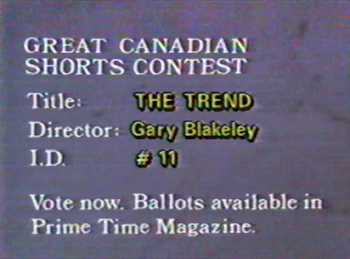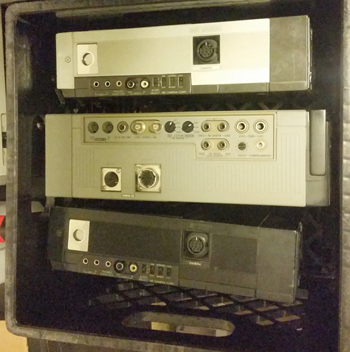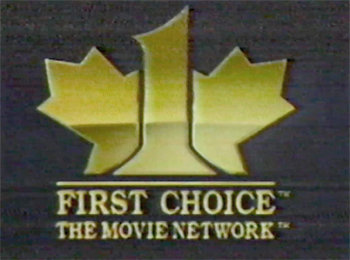(Mis)Adventures in Video, Part III: Film School Snapshots & Gary Blakeley’s The Trend (1987)
As I’ve been digging through what I guess can be called my personal archives (aka The Hasonian), filed in a box was a rare thing (of sorts) which requires a lengthy backstory before I go any further.

When I started film school at York University (this is all pre-rapid construction boom, when the Ross Building was the university’s biggest unobstructed Brutalist beast, standing rude, plain and naked for all to see, fear, and loathe), I managed to build up the courage and convince my dad to FINALLY get Pay TV [PTV] – I say finally, because he never wanted it, really didn’t need it, and not unreasonably, didn’t want his bill with Rogers going up yet again.
PTV offered uncut movies and oddball miscellaneous shorts, and in the late 80s & early 90s, there were two channels that held control over different regions: Super Channel in the west, and First Choice in the east. Both eventually merged into The Movie Network, but whilst I was at York, it was First Choice [FC] as the only option, which if memory serves correct, was around $15 / month on top of extended cable. (In a later blog I’ll go into my early years with cable TV, when Rogers’ monthly bills were less than $5. Ahem.)

Early into film school, FC started The Great Canadian Shorts Contest in which accepted submissions would be aired between feature films, and viewers could vote on entries using ballots in FC’s Prime Time magazine.
(I wish I’d kept back issues, but they went through the usual routine practiced by avid home viewers & home tapers: you’d examine the listings, and with a red pen mark off what you’d want in both the PTV guide, and Broadcast Week, the latter a TV guide that came with the Globe & Mail. The sublime retentia of how one organized one’s viewing and taping schedule to ensure the maximum capturing of content will be the focus of a separate blog.)
Now, anytime a film student heard of a venue where they might be able to screen their work, big bright incandescent light bulbs snapped on in their noodles. FC’s contest actually ran for a few years. A classmate’s Year 3 documentary on Toronto’s longtime ice cream shop extraordinaire, Dutch Dreams, aired a few times. (Yariv Kohn was the writer-director, and his short captured the parlour in its original location with its original décor, some of which I believe was lost in a fire a couple of years later.)

One short that enjoyed regular rotation was Gary Blakeley’s The Trend (1987), a brilliant, absurdist satire on (what else?) ridiculously fashionable trends. Instead of sunglasses, shoes, or cars, the showcased trend was people wearing outboard motors like a knapsack, only heavier, and utterly functionless.
Because I was rabidly taping / watching / archiving FC content on VHS, it was easy to ensnare a short – in this case I’d set the timer to record a block of movies, so sandwiched between Roman Polanski’s Frantic (1988) and Jonathan Demme’s Something Wild (1986) was both The Trend, as well as snippets of trailers for that month’s new movies, plus an animated short-short.

I’d actually made a point of writing The Trend on the label so the tape wouldn’t get buried in what at its peak / most grotesque state had evolved / devolved into an archive of 2000+ VHS tapes. I’d always meant to digitize the short for personal amusement, so having retrieved the tape last month – spine number A. 547 – I was hoping it would play fine in one of my VCR’s, but one common issue plaguing old tapes recorded in EP / SLP is tracking, in which the tapes age and a VCR’s wear & tear plus any imperfections in the actual recording result in lines or streaks across the picture.
Sometimes the audio is garbled, and sometimes it’s fine, but tracking problems are most prominent in EP recordings, VHS-C EP recordings in particular, and even Hi-Fi recordings (often mandating the use of the mono linear audio tracks, because unlike Hi-Fi, which is embedded within the video signal, the audio won’t cut in & out as the video heads attempt to lock onto the video signal for stable playback).

I’ve many VCR’s – portables with manual tracking, consumer decks with auto and adjustable tracking, and prosumer & pro decks – but more often than not, it’s my old portables from the early to mid-1980s that can handle tracking-challenged tapes.

Physically, the tape was in fine shape, but after trying 5+ VCR’s, the best possible playback still contained tracking lines in the upper & lower frame extremes, and the only VCR that could handle it was my Quasar portable.
(Useless trivia: the tape’s number does indeed reflect it being the 547th VHS tape since my dad bought the first VCR in 1982 or 1983. So one can tabulate that between 1982-1988, pegging the median per tape cost to a slightly arbitrary $10, that’s $5,470.00 + taxes. Physical media… was never cheap… in those days.)

I’ve digitized The Trend and the aforementioned FC ‘Coming Soon’ ad (look for chopped down versions trailers for April upcoming Johnny be Good, The Last Emperor, The Telephone, Above the Law, 18 Again, Colors, The In Crowd, Eddie Murphy: Raw, She’s Having a Baby, Biloxi Blues, and other snippets), and an animated, dialogue-free short-short.
A few quick notes: I’ve uploaded the material to BHA’s YouTube channel and make it clear I do not own the copyright to any of the materials; they’re posted for non-commercial, archival enjoyment, and I will edit or remove anything if requested by the copyright holder(s).
I’d love to chat with Gary Blakeley in a proposed podcast, so if you’re reading this, do reach out via Facebook, Instagram, or Twitter, and perhaps we can have a great chat about making the the film, the uniqueness of York (you know what I mean), and later creative projects. (The last time I saw Blakeley’s name was in the humour section of maybe The Toronto Star, featuring a few stills of the old Bulova tower at the CNE and some dry commentary.)
I’d also like to point out some names in the credits of The Trend that have special meaning for me: P.F.A. Motion Picture Labs, a local post-production house that was one of a few main places us students got our 16mm films processed; and in the Special Thanks To credits, Vince Vaitiekunas (my Year 2 professor, THE most stubborn professor in history, and a character I miss), and David (Dave) Roebuck (my Year 4 professor, whose fascination with knurled rings was neverending).
At the very end of the short, do note the credit “Produced at York University Film/Video Department 1987.” The reason this became mandatory in 1992 is because my class (and myself) were so fed up with York’s bureaucratic levels that we refused to give overt credit to the department. Some of us (like myself) made our own company logos.

Pretty, isn’t it? Bedlam Productions. And it’s animated, too.
So to all subsequent film school students & grads, forced since 1991 to credit the university to ensure ownership and return of their film elements, and graduation, BLAME US.

YT flagged some music in the posted video – in The Trend, and in the FC ad – and one cited piece in the latter is “Raiders of Fortune” by C. (Christopher?) Palmer, which FC used over its logo. The triumphant stock music is from an album of trailer music called Corporate Adventure from Network Music – very 80s, and very different from subsequent styles in trailer scoring. Trailer editors often used pieces from existing soundtracks, and Hans Zimmer’s success during the 1990s also made his style of heavy bass booms and orchestral might the norm for more than a decade.
It’s a delight to hear Palmer’s full cue in stereo, but it’s a pity it’s not available on CD, like Yoav Goren’s Trailervision’s music; at least Palmer’s cue is available in some form to taste.
Also enjoy the period character generator and animated graphics in FC’s bumpers – they’re very iconic, and the purplish colours always looked partly slick and stylish. I think an affinity for that look is why I collect vintage video character generators which, sure, you can emulate with assorted software and plugins, but there is genuine joy in handling physical controls for title generators by minor and major names MFG, Panasonic, Scriptovision, and Videonics.
Lastly, this occasional series of blogs is part of a gradual progression towards a slightly autobiographical / mostly ridiculous podcast series on things York, things 90s, and things occasionally outrageous (and sort of true). Consider these chapters teasers to a multi-series narrative of quality nonsense.
Thanks for reading,
Mark R. Hasan, Editor
Big Head Amusements
